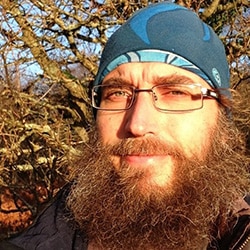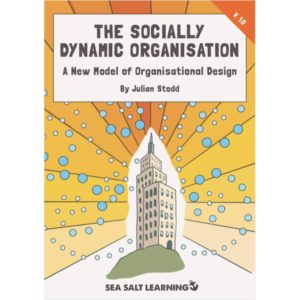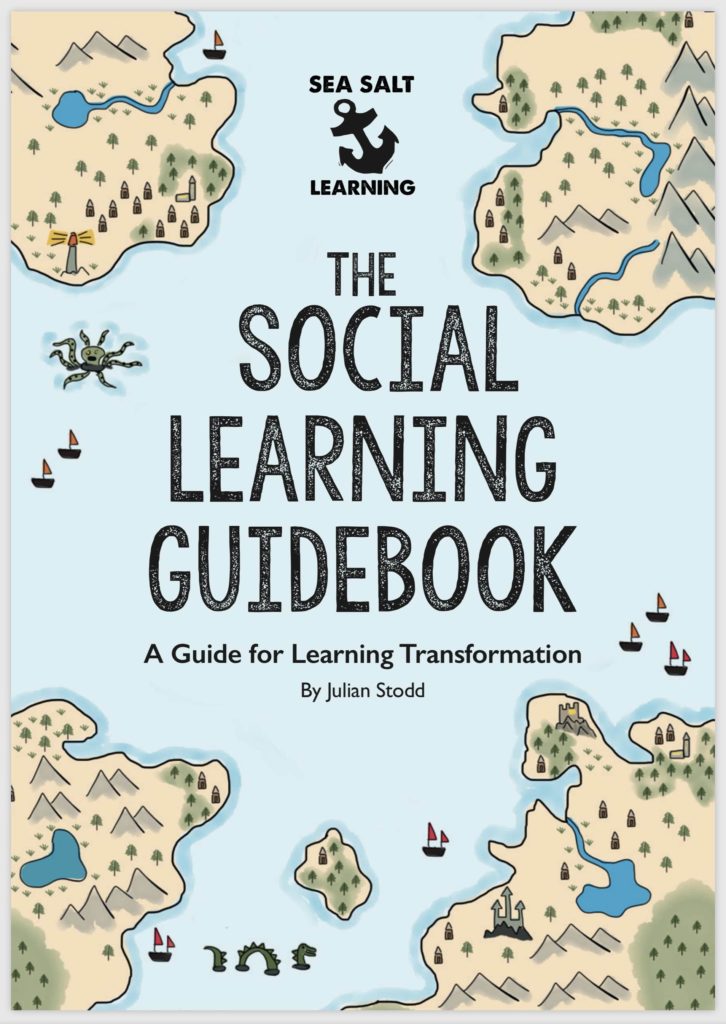Julian Stodd is a writer, illustrator, researcher, and explorer of the Social Age movement. He’s also founder and captain of Sea Salt Learning, where he helps organizations get fit for the social age.
As the author of fifteen books and thousands of articles and blog posts, Julian is a true thought leader in the areas of social leadership, organizational change, learning design, social collaborative technology, and more.
In this episode of the Leading Learning Podcast, co-host Jeff Cobb and Julian talk about what the social age is and what living in the social age means for learning and leadership. They also discuss social collaborative learning, the concept of expertise, storytelling, failure, the curse of busyness, and the related opportunities in all of this for learning businesses.
To tune in, listen below. To make sure you catch all future episodes, be sure to subscribe via RSS, Apple Podcasts, Spotify, Stitcher Radio, iHeartRadio, PodBean, or any podcatcher service you may use (e.g., Overcast). And, if you like the podcast, be sure to give it a tweet.
Listen to the Show
Access the Transcript
Download a PDF transcript of this episode’s audio.
Read the Show Notes
[00:00] – Intro
The Social Age
[01:29] – Would you tell us about your work?
Julian’s work explores aspects of social collaborative learning, leadership, the creation of culture, and models of change at the intersection of formal and social systems. “The social age” is the term he uses to describe the context of his work in organizations.
The social age describes a somewhat subtly evolved reality and the ways in which we need to adapt as a result of that. His work is exploratory and, by his own admission, quite often wrong. It’s a process of exploration, sense-making, and trying not to rely too much on what we’ve inherited.
Technology has changed almost everything, and he’s interested in the social nature of that change: seeing what’s changed in terms of social structures—and hence organizational or even national structures around that—and how we adapt to that new reality.
Watch the video below of Julian Stodd further explaining what it means to live in the social age.
Democratized Infrastructure and Radical Connectivity
[03:05] – Can you say more about the social age and what that means to you? For anyone engaged in designing and facilitating learning, social learning is also at play. Can you talk about how the social age and social learning potentially impact their work?
One broad societal trend is away from infrastructure being owned and controlled. Today, infrastructure is devolved and democratized. This gives an organization mass power and potential. As infrastructure becomes distributed, what an organization owns or holds becomes distributed.
Technology has given us is radical connectivity. Historically, our connection tended to be dictated by our language, geography, education, social status, etc., and was mostly local, similar, and dogmatic. Now it’s often global and distributed (but potentially still dogmatic).
We are radically connected in many different ways, across many different technologies, but that radical connection often happens in informal and hidden spaces. We start to paint a picture of individuals connected in local geographical structures, informal organizational structures, and globally distributed structures but being effective through all of them.
The very notion of what an organization is starts to blur around the edges at the same time as the notion of career fragments. The idea that you would spend 30 years working in one place is largely fiction to most people today.
And what I try to remember in my own work is that almost everything we see around us is made up. Very little of it is actually really real. It tends to be a matter of social convention and codified power and codified knowledge and so on and so forth. The structures of society are structures of education, are structures of finance, are structures of government and control. These are all made up, and all have changed in the past, and all will change in the future.
Julian Stodd
As we move into the post-industrial, hyper-connected world, we should ask ourselves, “What should we carry forward?” because we will need to invent the new structures that we’re going to inhabit.
Socially Constructed Reality and Learned Constraints
[07:07] – Along with radical connectivity, you talk about the idea of the democratization of capability. Capabilities that used to be centralized in organizations are now distributed to individuals. But you also say there’s a need for complex collaboration—potentially collaborating with people who are completely different from you, whom you disagree with, etc. Can you expand on that?
We inhabit a space of understanding, which is both individually created and socially co-created. Our understanding of pretty much anything is created as a group social phenomena. Very often we end up learning and performing within a socially constructed reality, which becomes set in stone. So we learn our own constraints.
When organizations talk about innovation and change, they are trying to reinvent themselves to do something different. But they’re trying to reinvent themselves within a glass bubble of learned constraint.
Also, reinvention, invention, and change challenge the power of today. People who hold power today are unlikely to want a future where they may not hold so much power. That rebalancing of power, the re-contracting of the social contract between individuals and organizations, is a core aspect of the social age. If we want people to be engaged, if we want to do things differently, and if we want to get the wisdom of broader knowledge and communities, we’ll have to earn it.
Sometimes that will be uncomfortable, so you tend to find that people split into three spaces:
- That which I know and I’m comfortable with
- That which I can tolerate as different
- That which I abhor
Understanding where those boundaries lie is important because we are likely to need a fracturing of our certainty if we truly wish to find some kind of advantage.
The Opportunity in Disruption
[10:26] – Radical connection opens up the possibility for other points of view, and we can invite that difference and disruption. Do you think in terms of actively inviting disruption in so that things get shaken up and we can start to think differently?
Julian is currently looking at how change happens through social movements. Social change tends to be about is about the fracturing of a legacy dominant narrative and the emergence and rapid prototyping of new dominant narratives.
That time of inflection is a painful one. You see the re-imposition of legacy power, the elasticity of social norms and narratives, and sometimes the emergence of the new. We see that at the moment in all sorts of ways—hybrid work, return to work, gender identity, etc. All kinds of social narratives are being challenged and stretched.
To say that opportunity lies through disturbance is blindingly obvious. Opportunity doesn’t lie in continuing to do the very same things we’ve already done.
What we’re often unwilling to entertain is the notion that we personally are wrong.
It’s quite easy to find a fault in others, but it’s quite difficult to find that disturbance in ourselves, especially when we’re busy. And busyness is the curse and the great excuse of modern organizations. It’s consistently the number one thing that people come up with to say they are unable to learn, to evolve, to change. They’re just too busy. But, when you think about it, it doesn’t seem all that likely…. We’ve probably just created systems that make us busy.
Julian Stodd
We are rewarded for being busy. We have a heroic culture of busyness that fails to question why we are so busy. Instead, we need to ask, “What could we stop doing? What could we dis-engineer? What could we take apart? What could we leave behind?”
Partner with Tagoras
[14:05] – At Tagoras, we’re experts in the global business of lifelong learning, and we use our expertise to help clients better understand their markets, connect with new customers, make the right investment decisions, and grow their learning businesses.
We achieve these goals through expert market assessment, strategy formulation, and platform selection services. If you are looking for a partner to help your learning business achieve greater reach, revenue, and impact, learn more at tagoras.com/services.
Being a Leader in the Social Age
[14:40] – How is leadership different in the types of structures that you’re describing? How can somebody who aspires to lead or is leading accomplish that in the social age?
Julian’s work on social leadership looks at leading at the intersection of systems. It doesn’t say we need to get rid of what came before; it says we need to broaden and add to it.
Roughly speaking, in the industrial organization we needed a type of leadership that was about resource management and control. It was about collecting diverse talent and using systems, processes, and established power to direct that talent. This built a pyramid with people at the top holding power and people at the bottom doing the work (the traditional view of the modern organization).
What we need to do now is to add to that to make it a multidimensional organization. We still need some formal power, but we also need social. We need the authority-led organization and authentic leaders who are connected within many and diverse communities. These leaders also need to understand these communities and the types of power that operate in those spaces.
When we look at the ways we rewire or rebuild our organizations, it’s likely to include both a formal and a social perspective. This recognizes that people collaborate in different ways and different spaces and that trust flows unevenly between spaces. We can see this happening with organizations that scale without accruing much hierarchy, system, and process.
Typically, the very mechanisms that made us safe yesterday cast a shadow into the future. And very few organizations have a specific capability in dis-engineering themselves. They tend to just bolt things on or acquire things, but they never truly rewire themselves from within, and I think that’s one of the great challenges today.
Julian Stodd
Julian says his book The Socially Dynamic Organisation: A New Model of Organisational Design is one of the most important things he’s written. That’s because you have to think about what type of organization you’ll design, how you’ll lead within it, and how people will people learn within it.
Storytelling
[19:17] – You emphasize the importance of leaders being able to tell authentic stories and the connection between story and culture. Culture seems deeply embedded into the idea of the social age and the idea of being able to make progress and change. Would you elaborate?
Storytelling has come under fire recently, but that has more to do with some of the programs and quality of work around storytelling that you see. Julian is primarily interested in the way that we construct different narratives—individually, collectively, and organizationally—and how they intersect.
When we lead, we seek to project stories and create a space for people to invest themselves in stories. We are narrative creatures at heart. Stories we read are captured within books, and hence they’re like pinned butterflies. We need a mixture of both the stories we read and the stories we tell.
Learning Business Leaders As Story Weavers
[21:19] – Leading Learning Podcast listeners are (or could be) the weavers of stories across the networks and communities that they serve, the groups of people for whom they’re creating and facilitating learning experiences. Do you see anything different about how learning business professionals might use stories as opposed to, say, an L&D professional in a corporation? Or is it the same dynamic, regardless?
Julian quips that we should have invited Sae Schatz back for this part of the conversation.
Cognitively, certain aspects are the same—the way that we respond to stories and the way that we frame our learning and understanding within them. But, because the context is different, the role of stories is different. Julian is more interested in social collaborative models of learning, which typically use narrative and discourse structures to allow the social co-creation of knowledge within a scaffolding or framework.
Typically, there’s a background, framework, or chapter/narrative structure that we want a program to hold. It’s then about how much knowledge you want to put into it and how much you want to create space for divergent understanding to emerge.
Learning business leaders probably have a less formally mandated structure in terms of what learning looks like, but Julian still thinks that there’s the need to scaffold experiences to help guide people. At the very lightest level, sometimes Julian uses “campfire conversations,” one to three questions to guide people into uncertainty. It’s a gift to give people a space to be uncertain in.
We pick up words like tokens as if they carry implicit meaning, but, in fact, the meaning they have is imbued in them. So the more conversation and exploration you can do, the more meaning you can find.
Julian notes that he and Donald Clark regularly explore their differences around leadership, storytelling, and more. Recently, they’ve been talking about the relationship between language and meaning, specifically, the extent to which learning is a process that can either be constrained or enabled by our existing language.
To learn more about Sae’s and Donald’s work, see our related episodes:
The Concept of Expertise
[25:55] – In our world of lifelong learning, continuing education, and professional development, people running programs may be trying to impose a formal and measurable structure on experiences where the most value might come from the informal and less structured aspects. It’s often about the distribution of what gets thought of as expertise. Can you be an expert, though? Or is expertise just a myth that we’ve created for ourselves?
Julian thinks our understanding of expertise is probably incomplete. His free e-book The Social Learning Guidebook deals with social and collaborative learning.
The notion of expertise is largely a pragmatic one. Expertise is very real—both deep expertise and also the expertise of interconnection. To some extent, we are in the age of the generalist, where good enough is good enough.
There are instances when expertise needs to be deep and validated, and there are instances when cursory knowledge is enough. The trick is knowing which space you are in.
Julian Stodd
Today we can probably gain access—through our networks of primary and secondary connections—to much broader capability and expertise than in the past. That in itself may challenge us more, but it gives us a richer environment in which to explore.
A modern organization should have a direct, employed base but also an aligned or engaged base and understand that networks are more layered than in the past. This leads to how we need to think about boundaries and how we will we earn the right to be in conversations.
Lifelong Learning Habits
[30:15] – Writing and illustration are at the core of your lifelong learning. How did that come to be? And how do writing and illustration fit into how you go about your own lifelong learning?
After selling his e-learning business in 2010, Julian got back into writing. He started writing about the social age in a very conversational style using WordPress, and he loved it.
A couple of years later when the iPad came out, he began integrating illustrations into his writing, and the illustrations drove engagement up a hundredfold. He now writes every day and adheres to a principle of working out loud, where he shares his evolving thinking.
See our related episode “Working Out Loud with John Stepper.”
Julian typically starts with the illustration and then writes around it. Illustrations give us language, so his output is very wrapped up in illustration and writing—the illustrating helps him think, and thinking helps him write. He also notes that he’s just embarking on the journey to tackle The Learning Science Guidebook with Sae Schatz.
Writing is something that brings us together, but the trick is to remember that difference is actually a good thing. Julian is okay critiquing his own work because it’s full of holes.
If you want certainty, do what everybody else does, and being sure about those things other people are sure about. But, if you really want to learn, you need uncertainty, and you need to test things in practice and be willing to learn from it, which can be painful and uncomfortable. And it won’t happen by chance. You have to curate or create the environment in which that can happen.
Julian Stodd
[35:31] – Wrap-up
Julian Stodd is founder and captain of Sea Salt Learning. His blog is a great way to go deeper into the subjects discussed in this episode (and an excellent example of working out loud), so we recommend you check it out.
To make sure you don’t miss new episodes, we encourage you to subscribe via RSS, Apple Podcasts, Spotify, Stitcher Radio, iHeartRadio, PodBean, or any podcatcher service you may use (e.g., Overcast). Subscription numbers give us some data on the impact of the podcast.
We’d also be grateful if you would take a minute to rate us on Apple Podcasts at https://www.leadinglearning.com/apple or wherever you listen. We personally appreciate reviews and ratings, and they help us show up when people search for content on leading a learning business.
Finally, consider following us and sharing the good word about Leading Learning. You can find us on Twitter, Facebook, and LinkedIn.
Episodes on Related Topics:





 Tool Talk: MIDDLE ME
Tool Talk: MIDDLE ME
Leave a Reply